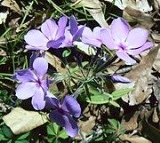
Phlox divaricata
Encyclopedia
Phlox divaricata is a herbaceous
perennial
valued for its lavender-blue flowers, native to forests and fields in eastern North America
.
2.5-5 cm in length and ovate-lanceolate in shape.
Flower
s appear in early spring and are 2-4 cm in diameter, with five petal
s fused at the base into a thin tube.
Herbaceous plant
A herbaceous plant is a plant that has leaves and stems that die down at the end of the growing season to the soil level. They have no persistent woody stem above ground...
perennial
Perennial plant
A perennial plant or simply perennial is a plant that lives for more than two years. The term is often used to differentiate a plant from shorter lived annuals and biennials. The term is sometimes misused by commercial gardeners or horticulturalists to describe only herbaceous perennials...
valued for its lavender-blue flowers, native to forests and fields in eastern North America
North America
North America is a continent wholly within the Northern Hemisphere and almost wholly within the Western Hemisphere. It is also considered a northern subcontinent of the Americas...
.
Description
Wild phlox grows 25-50 cm tall with opposite, unstalked leavesLeaf
A leaf is an organ of a vascular plant, as defined in botanical terms, and in particular in plant morphology. Foliage is a mass noun that refers to leaves as a feature of plants....
2.5-5 cm in length and ovate-lanceolate in shape.
Flower
Flower
A flower, sometimes known as a bloom or blossom, is the reproductive structure found in flowering plants . The biological function of a flower is to effect reproduction, usually by providing a mechanism for the union of sperm with eggs...
s appear in early spring and are 2-4 cm in diameter, with five petal
Petal
Petals are modified leaves that surround the reproductive parts of flowers. They often are brightly colored or unusually shaped to attract pollinators. Together, all of the petals of a flower are called a corolla. Petals are usually accompanied by another set of special leaves called sepals lying...
s fused at the base into a thin tube.

